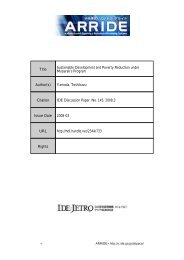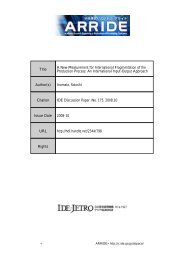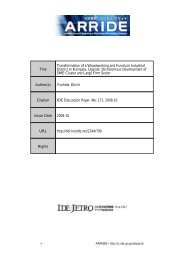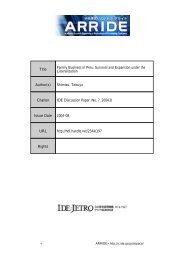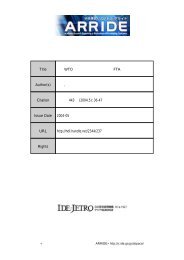Title Financing Small and Medium Enterprises in Myanmar Author(s ...
Title Financing Small and Medium Enterprises in Myanmar Author(s ...
Title Financing Small and Medium Enterprises in Myanmar Author(s ...
Create successful ePaper yourself
Turn your PDF publications into a flip-book with our unique Google optimized e-Paper software.
<strong>Myanmar</strong> Agriculture Development Bank (MADB). In the bank<strong>in</strong>g sector, only MEB,<br />
MICB, <strong>and</strong> MFTB are allowed to h<strong>and</strong>le foreign exchange operations. However, most of<br />
the foreign bank operations are undertaken by MICB <strong>and</strong> MFTB. MFTB h<strong>and</strong>les<br />
foreign currency transactions of government organizations, bus<strong>in</strong>esses, <strong>and</strong> <strong>in</strong>dividuals.<br />
MICB primarily deals with companies <strong>and</strong> jo<strong>in</strong>t ventures. MEB h<strong>and</strong>les foreign<br />
currency transactions <strong>in</strong> border trade regions. No private banks are allowed to h<strong>and</strong>le<br />
foreign exchange transactions <strong>in</strong> <strong>Myanmar</strong>.<br />
The <strong>in</strong>terest rates <strong>in</strong> the bank<strong>in</strong>g sectors are negative <strong>in</strong> real term due to high<br />
domestic <strong>in</strong>flation. Previously, the Central Bank of <strong>Myanmar</strong> determ<strong>in</strong>es <strong>in</strong>terest rates<br />
<strong>and</strong> allows private banks a 3-percent leeway to set their own rate. For example, the<br />
central bank determ<strong>in</strong>es <strong>in</strong>terest rate at 12 percent, then private banks are not allowed<br />
to set less than 9 percent <strong>in</strong>terest rate for deposit. Similarly, private banks cannot set<br />
their lend<strong>in</strong>g rate to more than 15 percent. In 2006, the central bank hiked <strong>in</strong>terest rate<br />
for deposit <strong>and</strong> loan up to 12 percent <strong>and</strong> 17 percent, respectively. All banks are<br />
required to determ<strong>in</strong>e their <strong>in</strong>terest rates accord<strong>in</strong>g to this new rate.<br />
Inflation rate <strong>in</strong> <strong>Myanmar</strong> ranged from20 percent to 40 percent for the past years.<br />
The bank<strong>in</strong>g crisis <strong>in</strong> <strong>Myanmar</strong>, which occurred <strong>in</strong> February 2003, was triggered by the<br />
collapse of a series on service firms (so called A-kyoe-saung). These companies normally<br />
started their bus<strong>in</strong>ess as brokerage firms <strong>in</strong> real estate <strong>and</strong> automobile. However, they<br />
started conduct<strong>in</strong>g <strong>in</strong>formal f<strong>in</strong>anc<strong>in</strong>g activities (even though this activity was not<br />
legally permissible) to many private bus<strong>in</strong>esses that do not have f<strong>in</strong>anc<strong>in</strong>g from formal<br />
sector or <strong>in</strong>adequate f<strong>in</strong>anc<strong>in</strong>g from formal sector. They acquired funds from public<br />
<strong>in</strong>vestors by offer<strong>in</strong>g very high <strong>in</strong>terest rates of 3 percent to 5 percent per month. Such<br />
returns were vastly excessive than the <strong>in</strong>terest rate that banks offered. The <strong>in</strong>vestors<br />
had little chance to know where to <strong>in</strong>vest their money via these service firms. Most of<br />
the service firms lend this money to private bus<strong>in</strong>esses with very high <strong>in</strong>terest rate of<br />
about 7 percent to 8 percent per month, but it was still lower than <strong>in</strong>formal sector<br />
<strong>in</strong>terest rate, which ranged from 10 percent to 20 percent. Most of the private<br />
bus<strong>in</strong>esses paid the <strong>in</strong>terest <strong>and</strong> the pr<strong>in</strong>cipal regularly when the bus<strong>in</strong>ess cycle<br />
prospered, but dur<strong>in</strong>g the economic crisis, they could not pay both <strong>in</strong>terest <strong>and</strong> pr<strong>in</strong>cipal.<br />
A crisis emerged, <strong>and</strong> it quickly extended <strong>in</strong>to the country’s emerg<strong>in</strong>g private bank<strong>in</strong>g<br />
sector. Long l<strong>in</strong>es of people <strong>in</strong> panic could be seen <strong>in</strong> front of private banks, wait<strong>in</strong>g for<br />
their turn to withdraw their money. The banks faced liquidity problems <strong>and</strong> the<br />
required amount of money was partly supplied by the central bank, but was <strong>in</strong>adequate.<br />
Therefore, some measures to limit the amount <strong>and</strong> number of withdrawals had to be<br />
made <strong>and</strong> loans were recalled whether or not they reached maturity, to solve liquidity<br />
problem. The manner of restrictions upon withdrawals <strong>and</strong> the recall of loans from



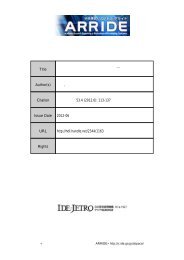
![Title [書評] 廣田義人著『東アジア工作機械工業の技術形成 ... - ARRIDE](https://img.yumpu.com/47139953/1/184x260/title-arride.jpg?quality=85)
